Hybrid Zoning Algorithm to Optimize Overhead in Smart Mobile Communication
Abstract
1. Introduction
2. Related Work
3. Problem Formulation
4. OLSR Protocol
4.1. The MPR Computation of OLSR
- Input: , , ;
- Start with an MPR set made of all members of with willingness equal to WILL_ALWAYS;
- calculate , where . is defined as the number of nodes ;
- if , m is the only node that covers a node ;
- Remove from all reached nodes by m;
- While there are nodes in which are not covered by at least one node in ;
- (a)
- Calculate for each . R(w) is the number of nodes in which are not yet covered by a node in and are reachable through w;
- (b)
- if w has the highest willingness with ;
- (c)
- In case of multiple choice, , u has the maximum reachability.
- (d)
- In case of multiple nodes providing the same amount of reachability, , where is greater; Remove , the nodes which are now covered by nodes in .
4.2. Default Forwarding Rules of OLSR
5. Zone Geographic Forwarding Rules
5.1. Extension of the Message Header
5.2. First Strategy: Acting on Nodes: Z-MPR Computation
- First, x changes the current plan to a new Cartesian coordinate of origin x, by deducing its coordinates from the position of all nodes in . The new coordinates of x are and the coordinates of a node are and .
- Then, x determines the zone of every neighbor within the new Cartesian coordinate system. Four cases are possible:
- and
- –
- if , u belongs to
- –
- if , u belongs to
- –
- if , u is on the border of and
- and
- –
- if , u belongs to
- –
- if , u belongs to
- –
- if , u is on the border of and
- and
- –
- if , u belongs to
- –
- if , u belongs to
- –
- if , u is on the border of and
- and
- –
- if , u belongs to
- –
- if , u belongs to
- –
- if , u is on the border of and
- Finally, the node x elects dispersive MPRs by selecting a node in each zone prioritizing odd zones to keep them away from each other. The new MPR computation algorithm is detailed below and summarized in Figure 9:
- Input: , , ; ; ;
- Start with an MPR set made of all members of with willingness equal to WILL_ALWAYS;
- calculate , where . is defined as the number of nodes ;
- if , m is the only node that covers a node ;
- Remove from all reached nodes by m;
- remove from Z the covered zone where m is located;
- While there are nodes in which are not covered by at least one node in ;
- (a)
- Calculate for each . R(w) is the number of nodes in which are not yet covered by a node in and are reachable through w;
- (b)
- if w has the highest willingness with ;
- (c)
- Remove from Z the new covered zone;
- (d)
- In case of multiple choice, , u has the maximum reachability. Remove from Z the new covered zones;
- (e)
- In case of multiple choice, , u is located in uncovered odd zone first, if not u is in an uncovered even zone with . Remove from Z the new covered zone.
- (f)
- In case of multiple choice, , where is greater; Remove from the nodes which are now covered by nodes in .
- (g)
- Remove from Z the new covered zone.
5.3. Second Strategy: Acting on Transmissions: Geographic Forwarding Rules
| Algorithm 1 Geographic forwarding rules of modified OLSR. |
|
6. Results
7. Conclusions
Author Contributions
Funding
Conflicts of Interest
Abbreviations
| OLSR | Optimized Link State Routing |
| AODV | Ad hoc On-demand Distance Vector |
| RR | Route Request |
| GPS | Global Positioning System |
| GFR | Geographic Forwarding Rules |
| MPR | Multipoint Relay |
| Z-MPR | Zone Multipoint Relay |
| Z-GFR | Zone Geographic Forwarding Rules |
| MANET | Mobile Ad hoc Network |
| QoS | Quality of Service |
References
- Al-Fuqaha, A.; Guizani, M.; Mohammadi, M.; Aledhari, M.; Ayyash, M. Internet of Things: A Survey on Enabling Technologies, Protocols, and Applications. IEEE Commun. Surv. Tutor. 2015, 17, 2347–2376. [Google Scholar] [CrossRef]
- Tuna, G.; Gungor, V.C. A survey on deployment techniques, localization algorithms, and research challenges for underwater acoustic sensor networks. Int. J. Commun. Syst. 2017, 30, e3350. [Google Scholar] [CrossRef]
- Tashtarian, F.; Sohraby, K.; Varasteh, A. Multihop data gathering in wireless sensor networks with a mobile sink. Int. J. Commun. Syst. 2017, 30, e3264. [Google Scholar] [CrossRef]
- Xin, H.; Yang, K. Routing Protocols Analysis for Internet of Things. In Proceedings of the 2015 2nd International Conference on Information Science and Control Engineering, Shanghai, China, 24–26 April 2015. [Google Scholar]
- Ahmed, E.; Yaqoob, I.; Gani, A.; Imran, M.; Guizani, M. Internet-of-things-based smart environments: State of the art, taxonomy, and open research challenges. IEEE Wirel. Commun. 2016, 23, 10–16. [Google Scholar] [CrossRef]
- Botta, A.; De Donato, W.; Persico, V.; Pescapé, A. Integration of Cloud computing and Internet of Things: A survey. Future Gener. Comput. Syst. 2016, 56 (Suppl. C), 684–700. [Google Scholar] [CrossRef]
- Singh, G.; Gupta, P.; Wahab, M.H.A. Smart Collision Avoidance and Hazard Routing Mechanism for Intelligent Transport Network. In IOP Conference Series: Materials Science and Engineering; IOP Publishing: Bristol, UK, 2017. [Google Scholar]
- Rath, M.; Pati, B.; Pattanayak, B.K.; Panigrahi, C.R.; Sarkar, J.L. Load balanced routing scheme for MANETs with power and delay optimisation. Int. J. Commun. Netw. Distrib. Syst. 2017, 19, 394–405. [Google Scholar] [CrossRef]
- Bruzgiene, R.; Narbutaite, L.; Adomkus, T. MANET network in Internet of things system. Ad Hoc Netw. 2017, 89. [Google Scholar] [CrossRef]
- Jacquet, P.; Muhlethaler, P.; Clausen, T.; Laouiti, A.; Qayyum, A.; Viennot, L. Optimized link state routing protocol for ad hoc networks. In Proceedings of the IEEE International Multi Topic Conference, IEEE INMIC, Lahore, Pakistan, 28–30 December 2001. [Google Scholar]
- Gómez, R.C.; Gonzalez-Herrera, I.; Bromberg, Y.D.; Réveillère, L.; Rivière, E. Density and Mobility-Driven Evaluation of Broadcast Algorithms for MANETs. In Proceedings of the 2017 IEEE 37th International Conference on Distributed Computing Systems (ICDCS), Atlanta, GA, USA, 5–8 June 2017. [Google Scholar]
- Liang, O.; Sekercioglu, Y.A.; Mani, N. A survey of multipoint relay based broadcast schemes in wireless ad hoc networks. IEEE Commun. Surv. Tutor. 2006, 8, 30–46. [Google Scholar] [CrossRef]
- Lakrami, F.; Elkamoun, N.; El Kamili, M. A survey on QoS for OLSR routing protocol in MANETs. In Proceedings of the International Symposium on Ubiquitous Networking, Casablanca, Morocco, 8–10 Septmber 2015. [Google Scholar]
- Trakadas, P.; Zahariadis, T. Design Guidelines for Routing Metrics Composition in LLN. Roll Internet Draft, 24 November 2012. [Google Scholar]
- Souidi, M.; Habbani, A.; Berradi, H.; Essaid, B. Node localization to optimize the MPR selection in smart mobile communication. In Proceedings of the 2017 International Conference on Smart Digital Environment, Rabat, Morocco, 21–23 July 2017. [Google Scholar]
- Souidi, M.; Habbani, A.; Berradi, H.; El Mahdi, F. Geographic forwarding rules to reduce broadcast redundancy in mobile ad hoc wireless networks. Pers. Ubiquitous Comput. 2018, 1–11. [Google Scholar] [CrossRef]
- Gao, Y.; Wang, H.; Weng, N.; Vespa, L. Enhancing Sensor Network Data Quality via Collaborated Circuit and Network Operations. J. Sens. Actuator Netw. 2013, 2, 196–212. [Google Scholar] [CrossRef]
- Luo, D.; Zhou, J. An improved hybrid location-based routing protocol for ad hoc networks. In Proceedings of the 2011 7th International Conference on Wireless Communications, Networking and Mobile Computing, Wuhan, China, 23–25 September 2011. [Google Scholar]
- Totani, Y.; Kobayashi, K.; Utsu, K.; Ishii, H. An efficient broadcast-based information transfer method based on location data over MANET. J. Supercomput. 2016, 72, 1422–1430. [Google Scholar] [CrossRef]
- Kavitha, K.; Selvakumar, K.; Nithya, T.; Sathyabama, S. Zone based multicast routing protocol for mobile ad-hoc network. In Proceedings of the 2013 International Conference on Emerging Trends in VLSI, Embedded System, Nano Electronics and Telecommunication System (ICEVENT), Tiruvannamalai, India, 7–9 January 2013. [Google Scholar]
- Farooq, M.U.; Tapus, N. CEHR: Core enabled hybrid routing protocol for mobile ad hoc networks. In Proceedings of the 2014 IEEE 10th International Conference on Intelligent Computer Communication and Processing (ICCP), Cluj Napoca, Romania, 4–6 September 2014. [Google Scholar]
- Hassan, M.H.; Mostafa, S.A.; Budiyono, A.; Mustapha, A.; Gunasekaran, S.S. A Hybrid Algorithm for Improving the Quality of Service in MANET. Int. J. Adv. Sci. Eng. Inf. Technol. 2018, 8, 1218–1225. [Google Scholar] [CrossRef]
- Bali, R.S.; Kumar, N.; Rodrigues, J.J. An efficient energy-aware predictive clustering approach for vehicular ad hoc networks. Int. J. Commun. Syst. 2017, 30, e2924. [Google Scholar] [CrossRef]
- Al-Baz, A.; El-Sayed, A. A new algorithm for cluster head selection in LEACH protocol for wireless sensor networks. Int. J. Commun. Syst. 2018, 31, e3407. [Google Scholar] [CrossRef]
- Majma, M.R.; Foladi, M.D.; Pedram, H.; Almassi, S. Grid based data dissemination protocol for mobile sink in wireless sensor network. In Proceedings of the 2012 2nd International eConference on Computer and Knowledge Engineering (ICCKE), Mashhad, Iran, 18–19 October 2012. [Google Scholar]
- Han, G.; Jiang, J.; Zhang, C.; Duong, T.Q.; Guizani, M.; Karagiannidis, G.K. A Survey on Mobile Anchor Node Assisted Localization in Wireless Sensor Networks. IEEE Commun. Surv. Tutor. 2016, 18, 2220–2243. [Google Scholar] [CrossRef]
- Vallikannu, R.; George, A.; Srivatsa, S. Autonomous localization based energy saving mechanism in indoor MANETs using ACO. J. Discret. Algorithms 2015, 33, 19–30. [Google Scholar] [CrossRef]
- Ramiro Martínez-de Dios, J.; Ollero, A.; Fernández, F.; Regoli, C. On-line RSSI-range model learning for target localization and tracking. J. Sens. Actuator Netw. 2017, 6, 15. [Google Scholar] [CrossRef]
- Qayyum, A.; Viennot, L.; Laouiti, A. Multipoint relaying for flooding broadcast messages in mobile wireless networks. In Proceedings of the 35th Annual Hawaii International Conference on System Sciences, HICSS, Big Island, HI, USA, 10 January 2002. [Google Scholar]
- Kitasuka, T.; Tagashira, S. Finding more efficient multipoint relay set to reduce topology control traffic of OLSR. In Proceedings of the 2013 IEEE 14th International Symposium and Workshops on a World of Wireless, Mobile and Multimedia Networks (WoWMoM), Madrid, Spain, 4–7 June 2013. [Google Scholar]
- Lin, K.; Chen, M.; Deng, J.; Hassan, M.M.; Fortino, G. Enhanced fingerprinting and trajectory prediction for IoT localization in smart buildings. IEEE Trans. Autom. Sci. Eng. 2016, 13, 1294–1307. [Google Scholar] [CrossRef]
- Mukherjee, S.; Biswas, G. Networking for IoT and applications using existing communication technology. Egypt. Inform. J. 2018, 19, 107–127. [Google Scholar] [CrossRef]
- The Network Simulator NS-3. Available online: https://www.nsnam.org/ (accessed on 29 June 2019).
- Aschenbruck, N.; Ernst, R.; Gerhards-Padilla, E.; Schwamborn, M. BonnMotion: A mobility scenario generation and analysis tool. In Proceedings of the 3rd International ICST Conference on Simulation Tools and Techniques, Malaga, Spain, 15–19 March 2010; pp. 1–10. [Google Scholar]
- Carneiro, G.; Fortuna, P.; Ricardo, M. FlowMonitor: A network monitoring framework for the network simulator 3 (NS-3). In Proceedings of the Fourth International ICST Conference on Performance Evaluation Methodologies and Tools, Pisa, Italy, 20–22 October 2009; pp. 1–10. [Google Scholar]
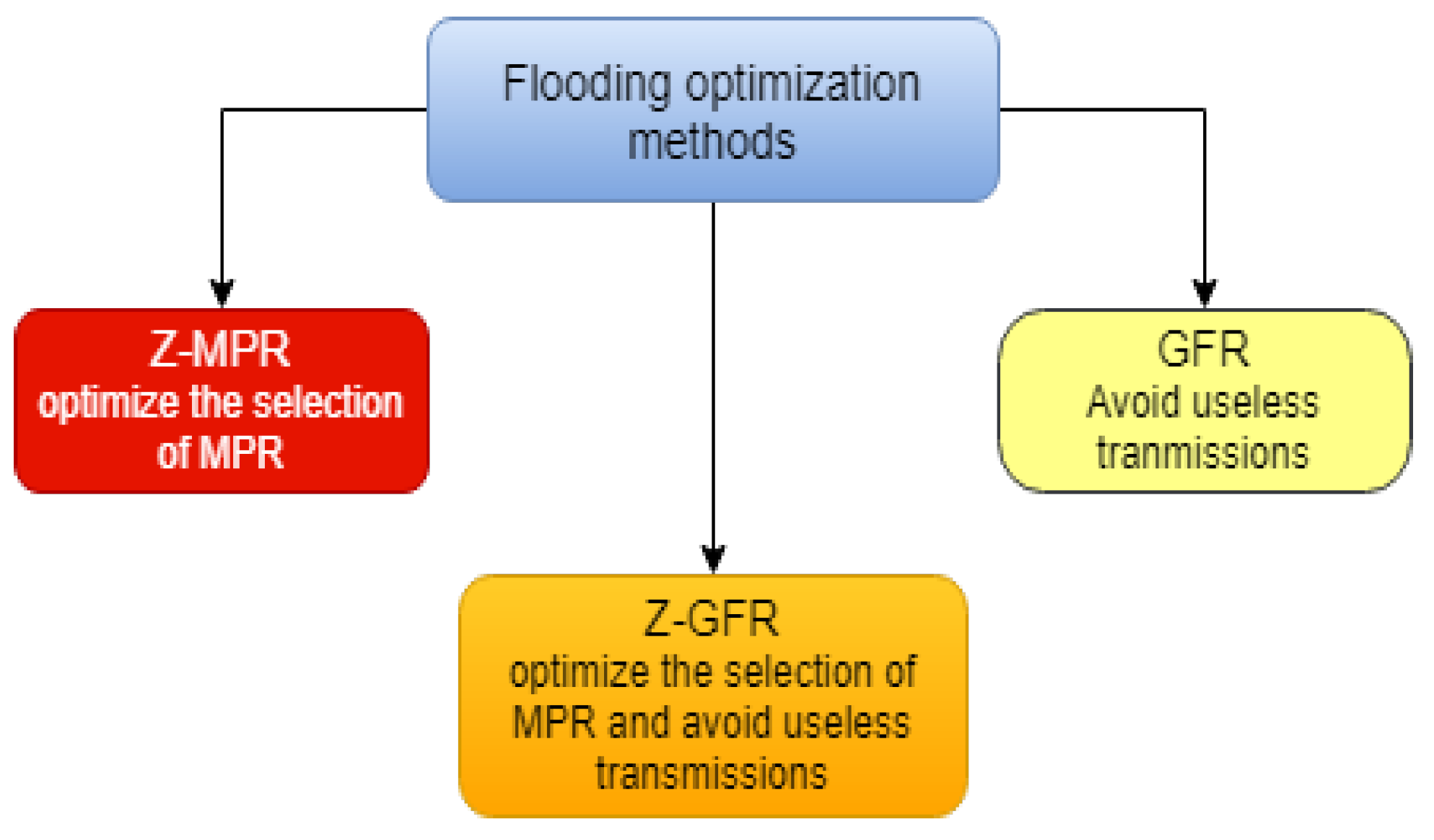
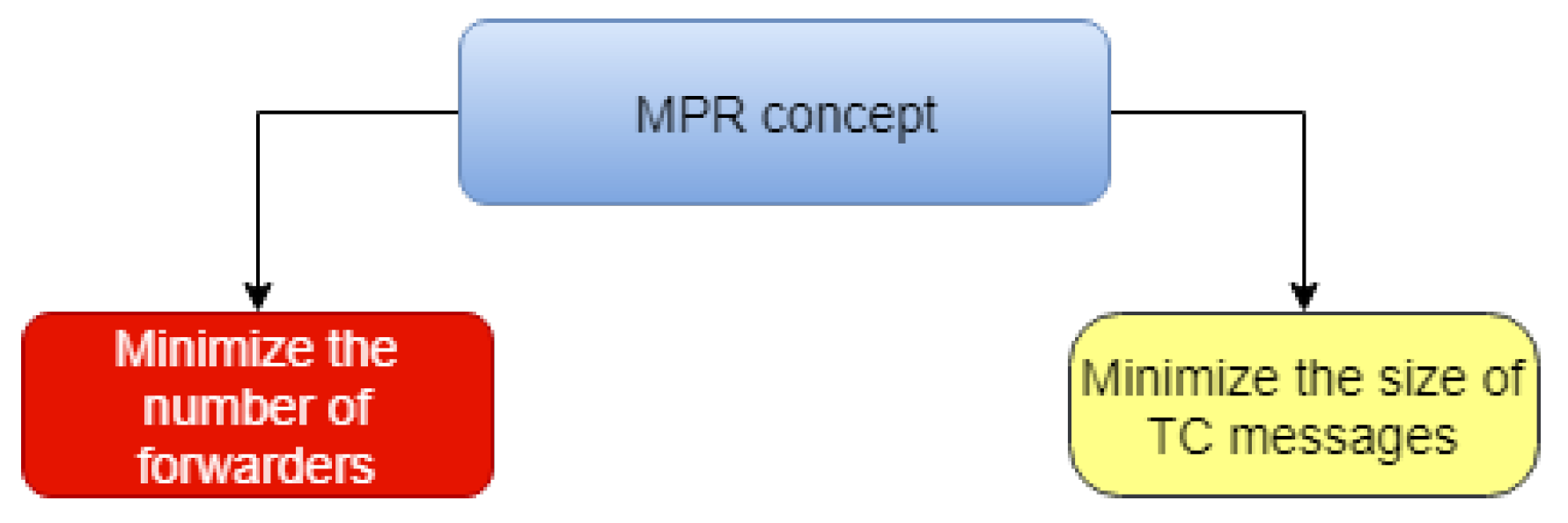
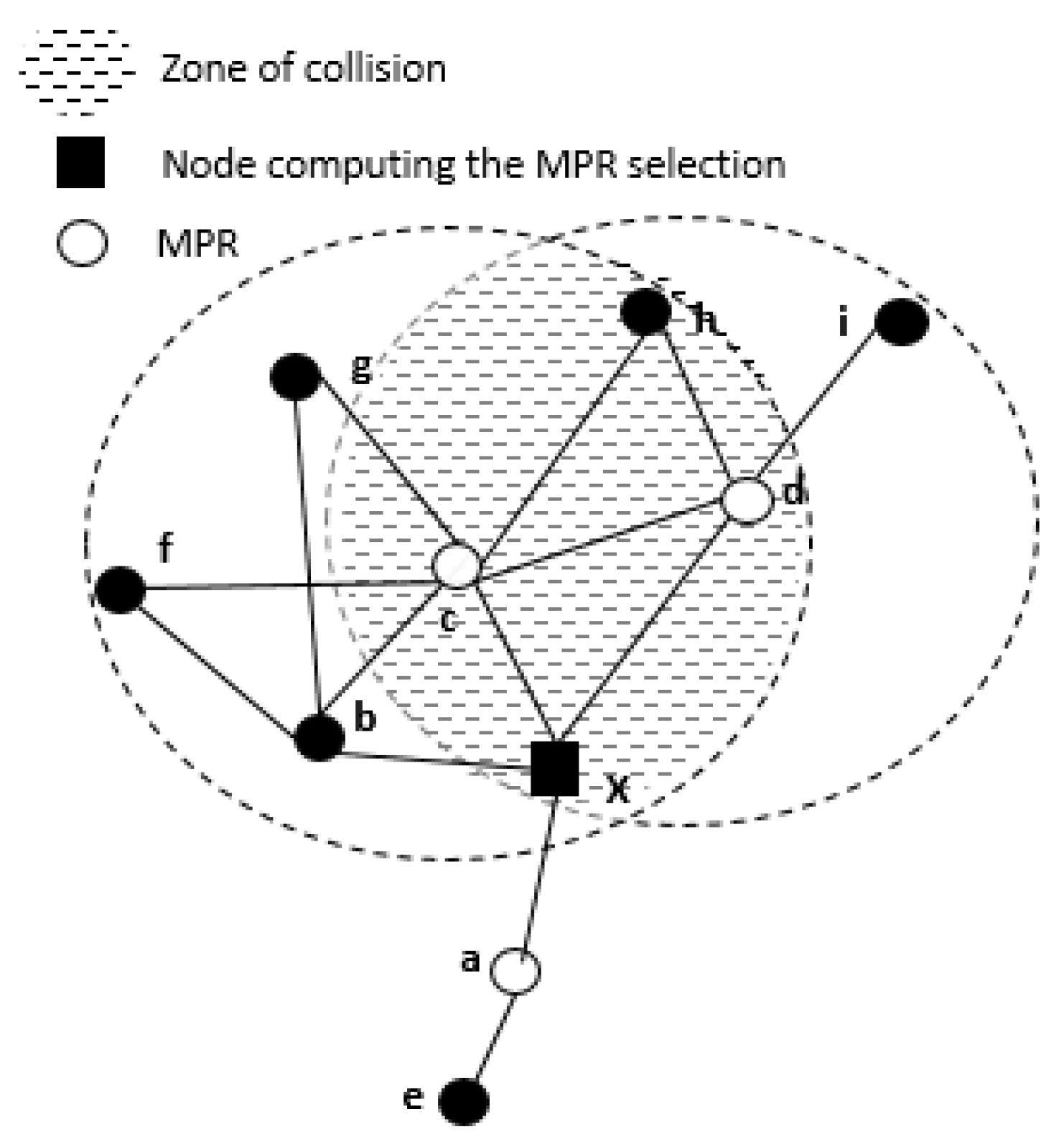
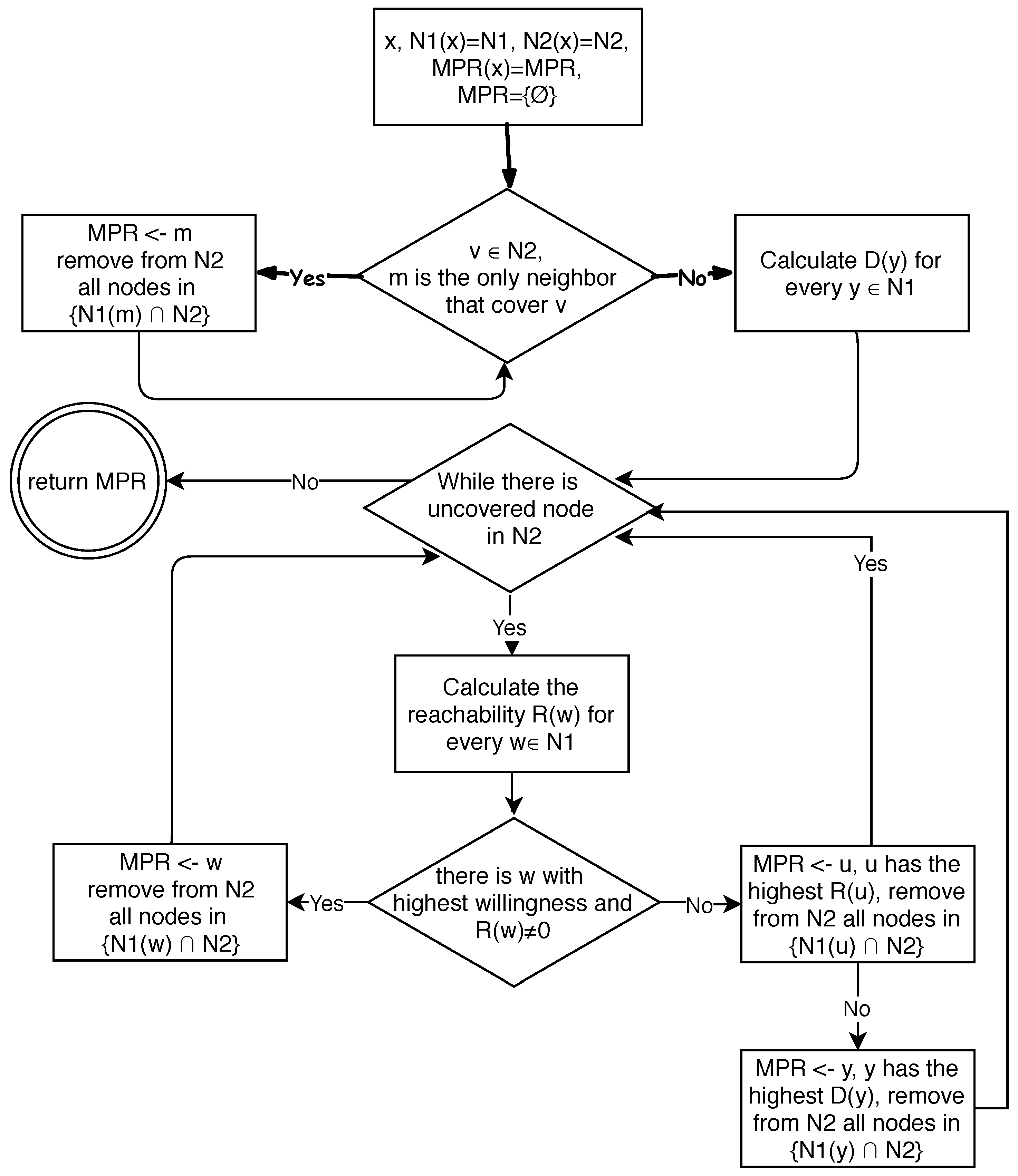
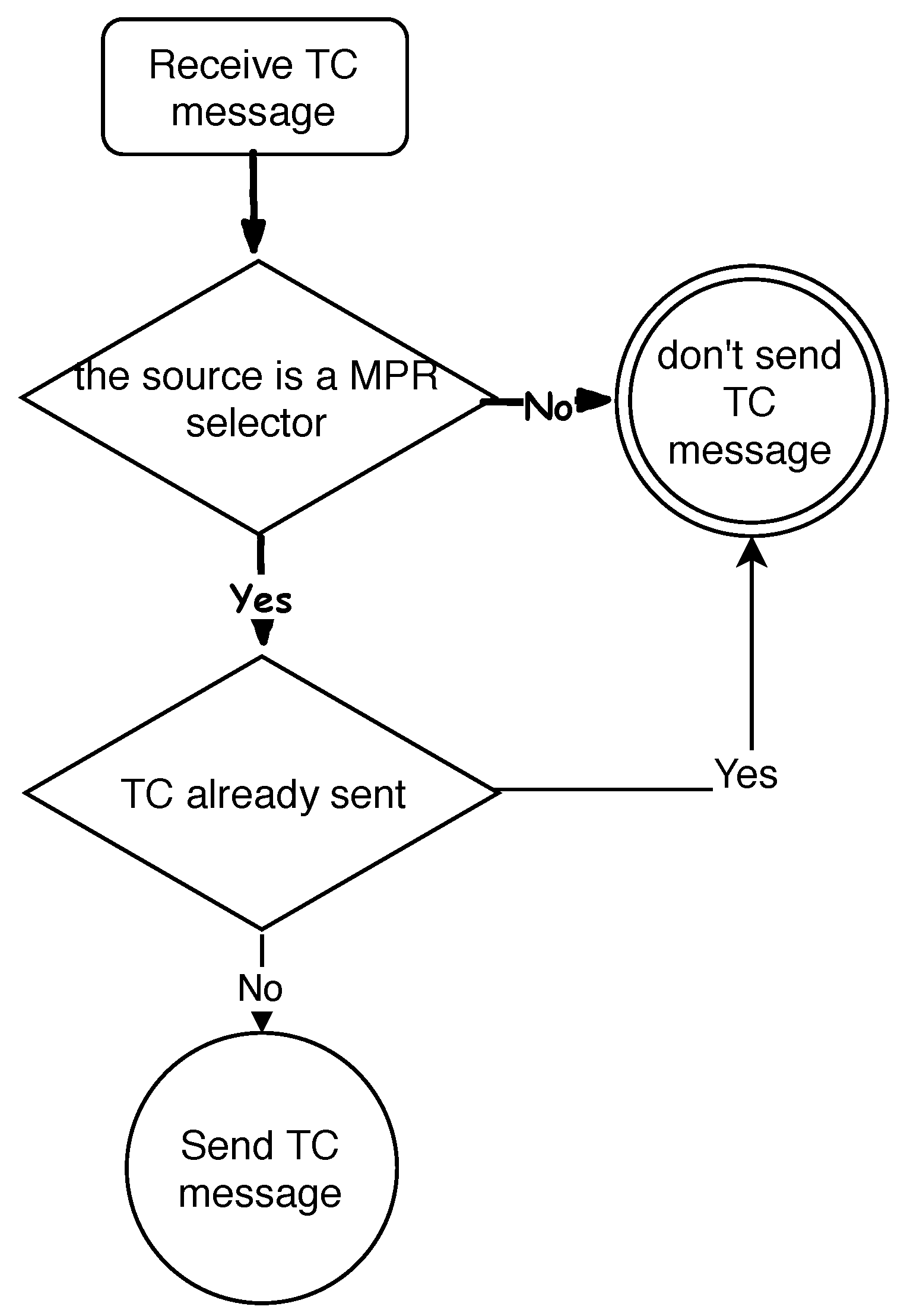

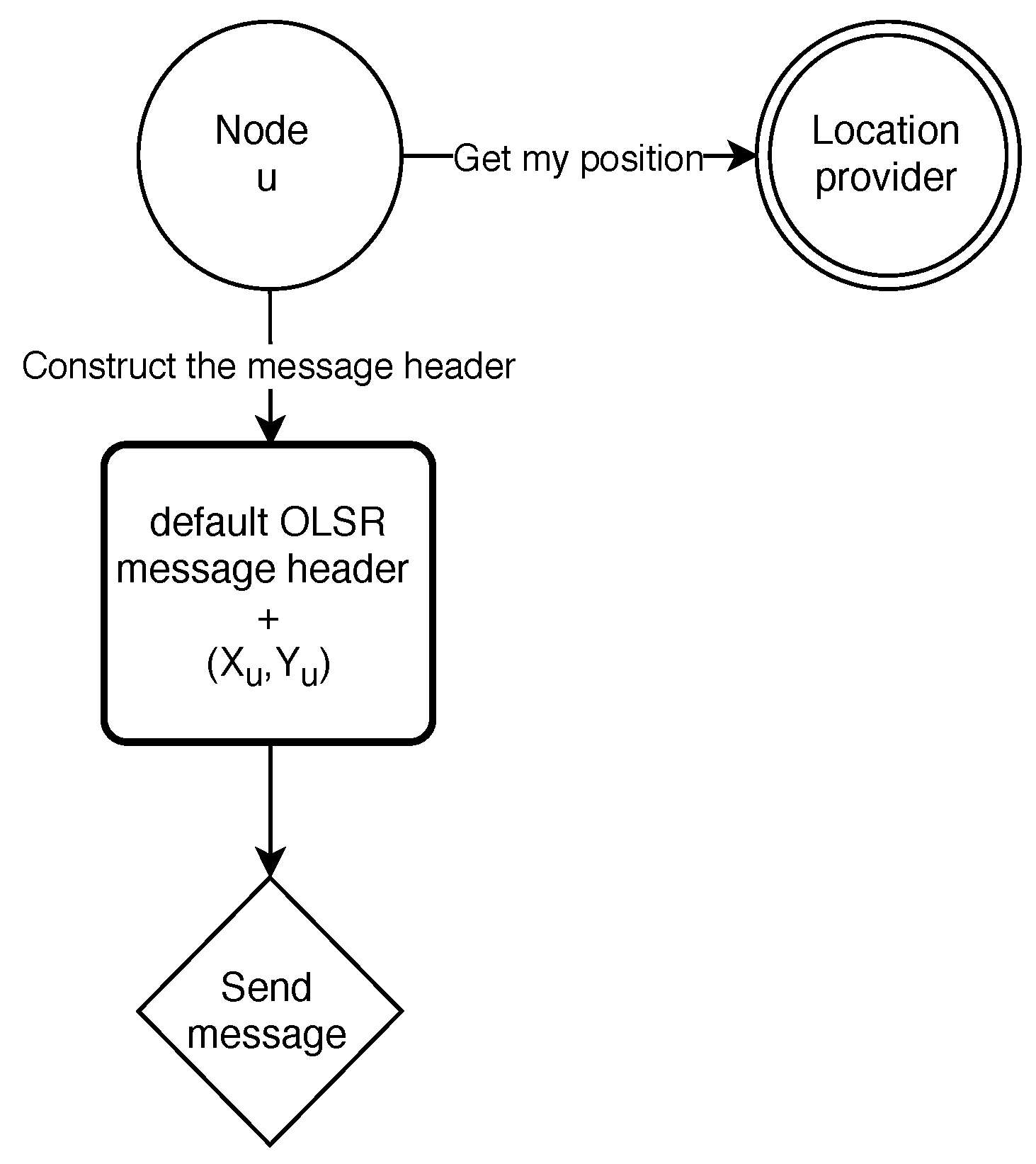
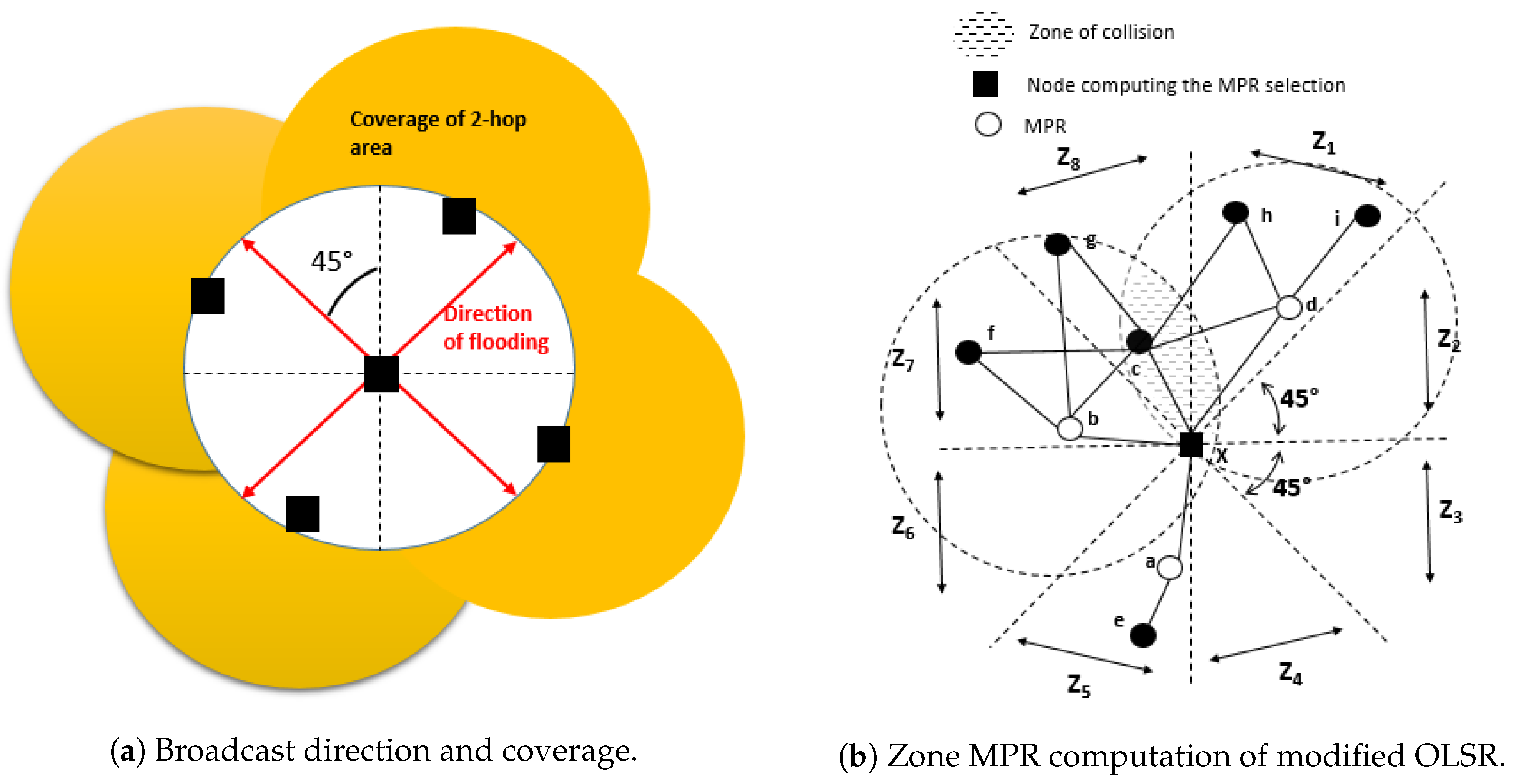
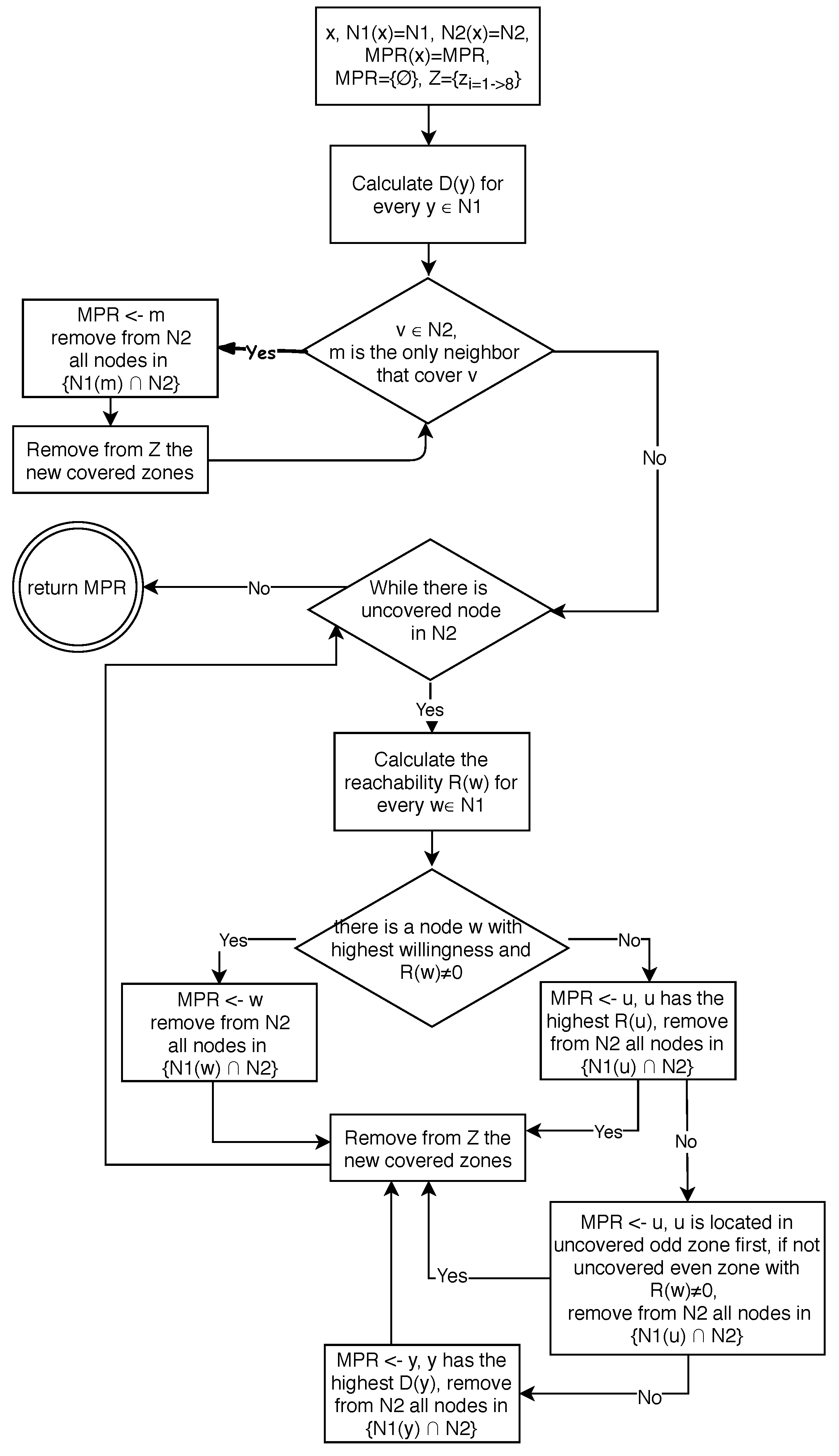
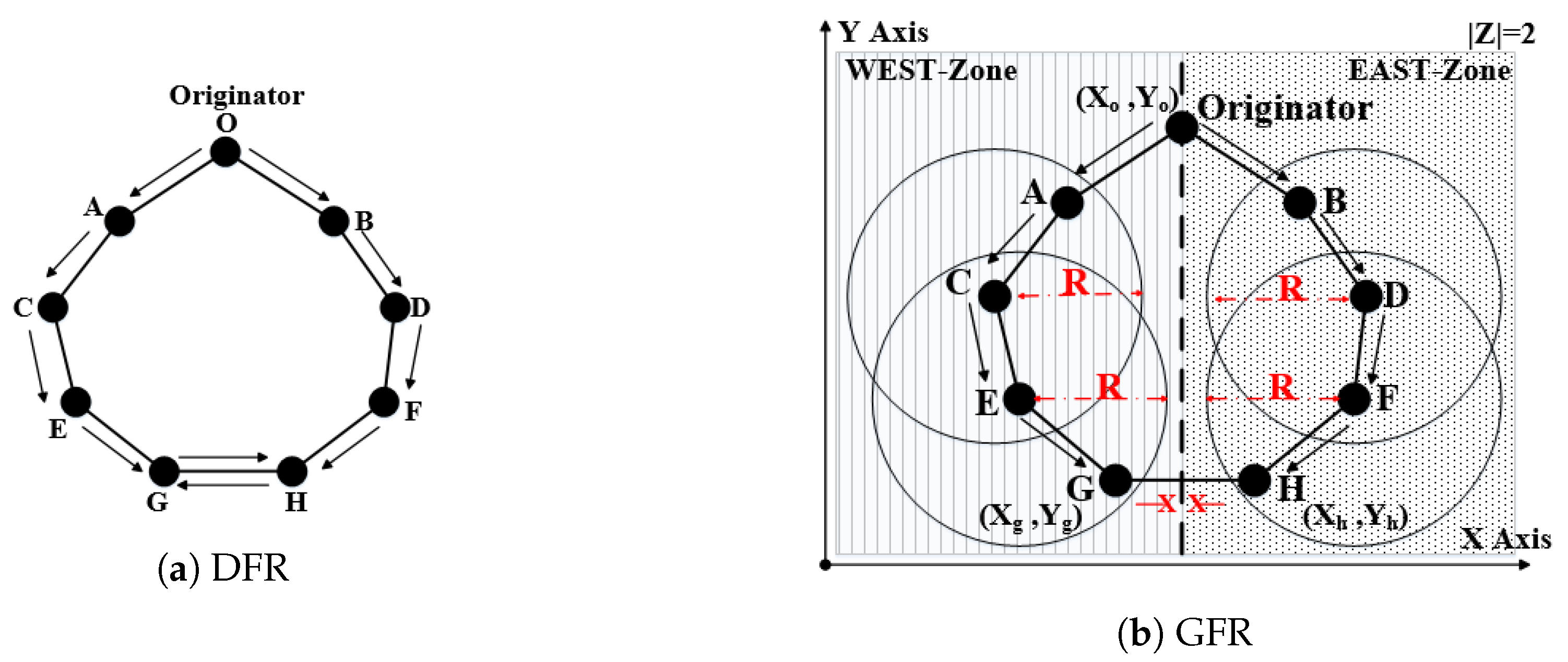
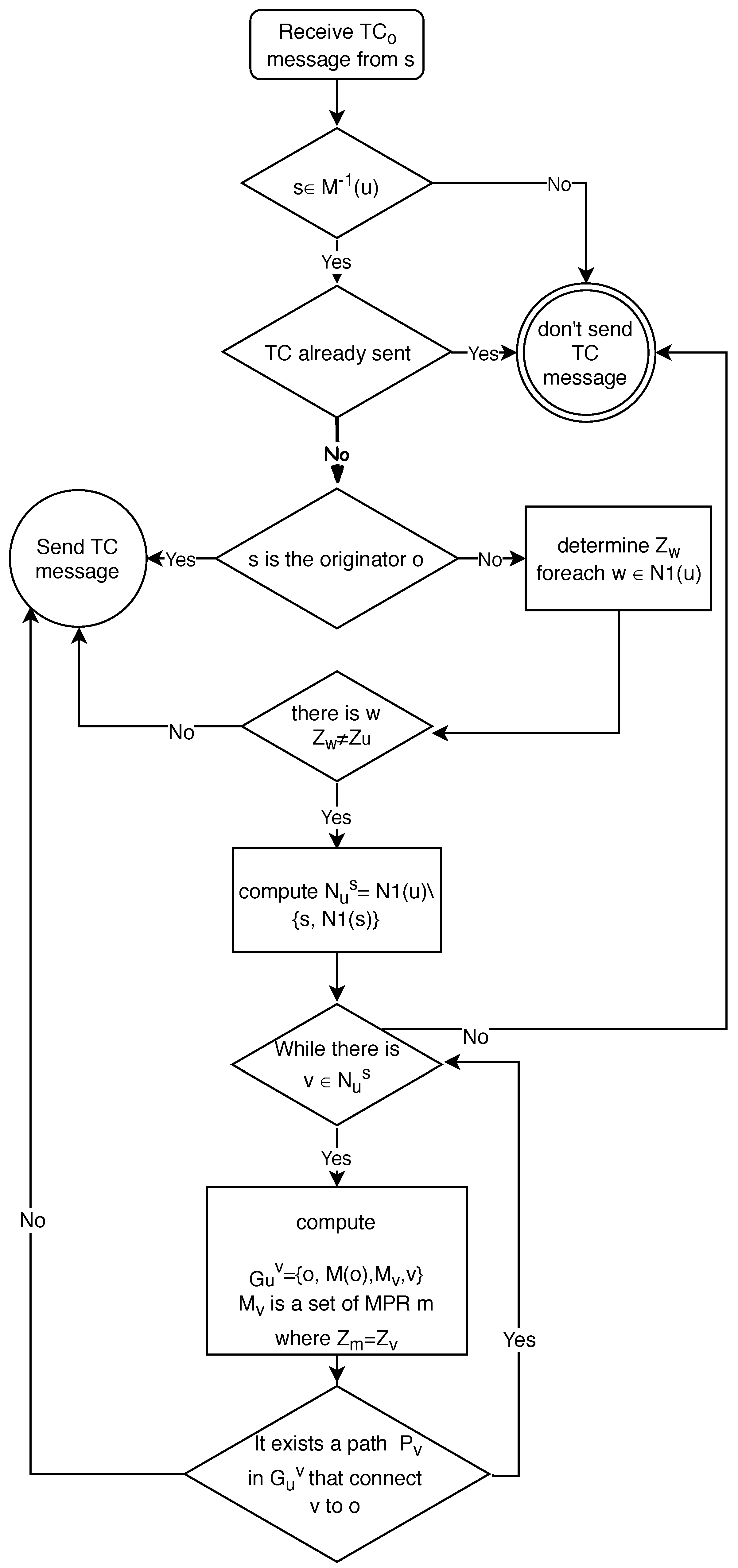
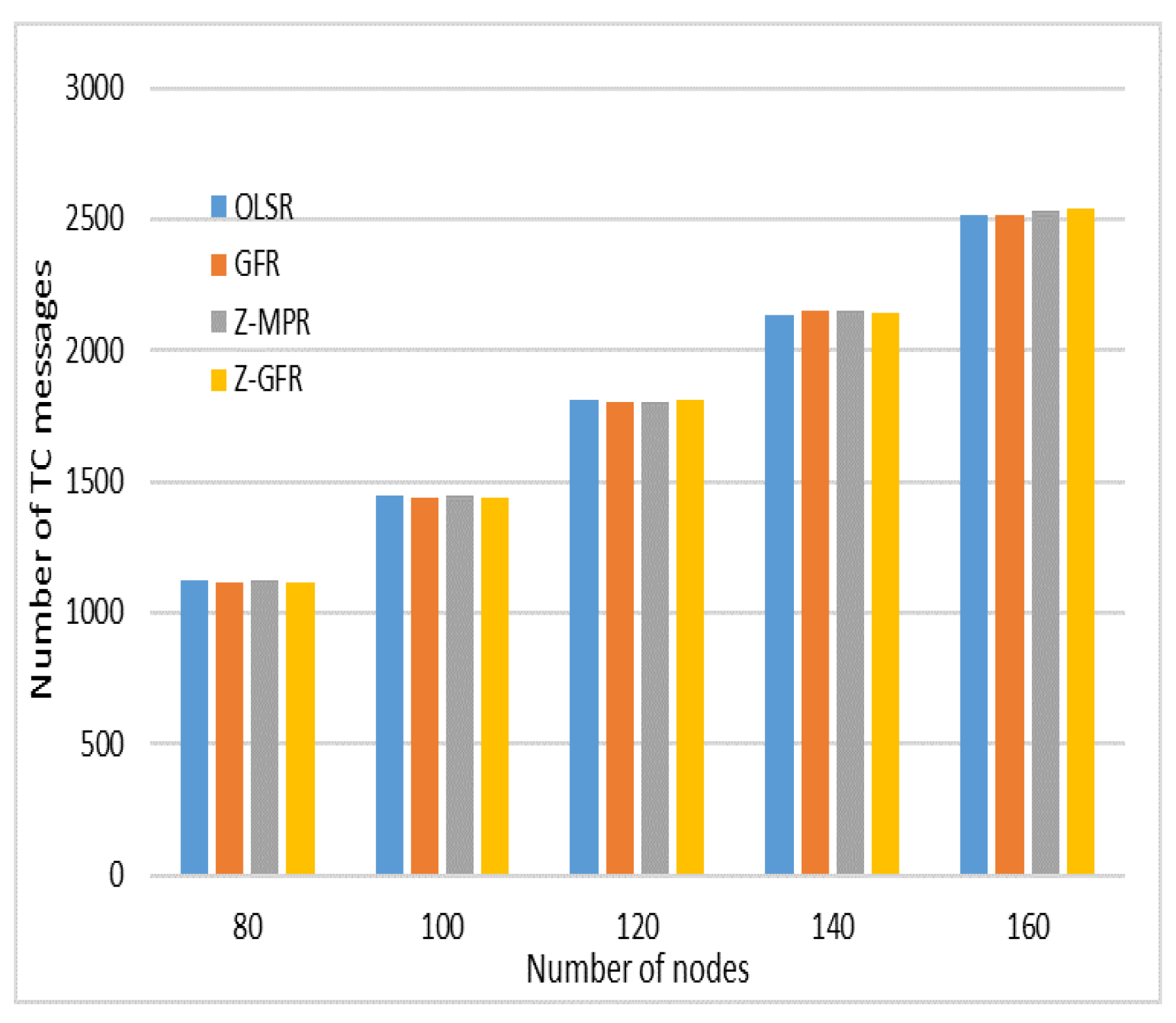
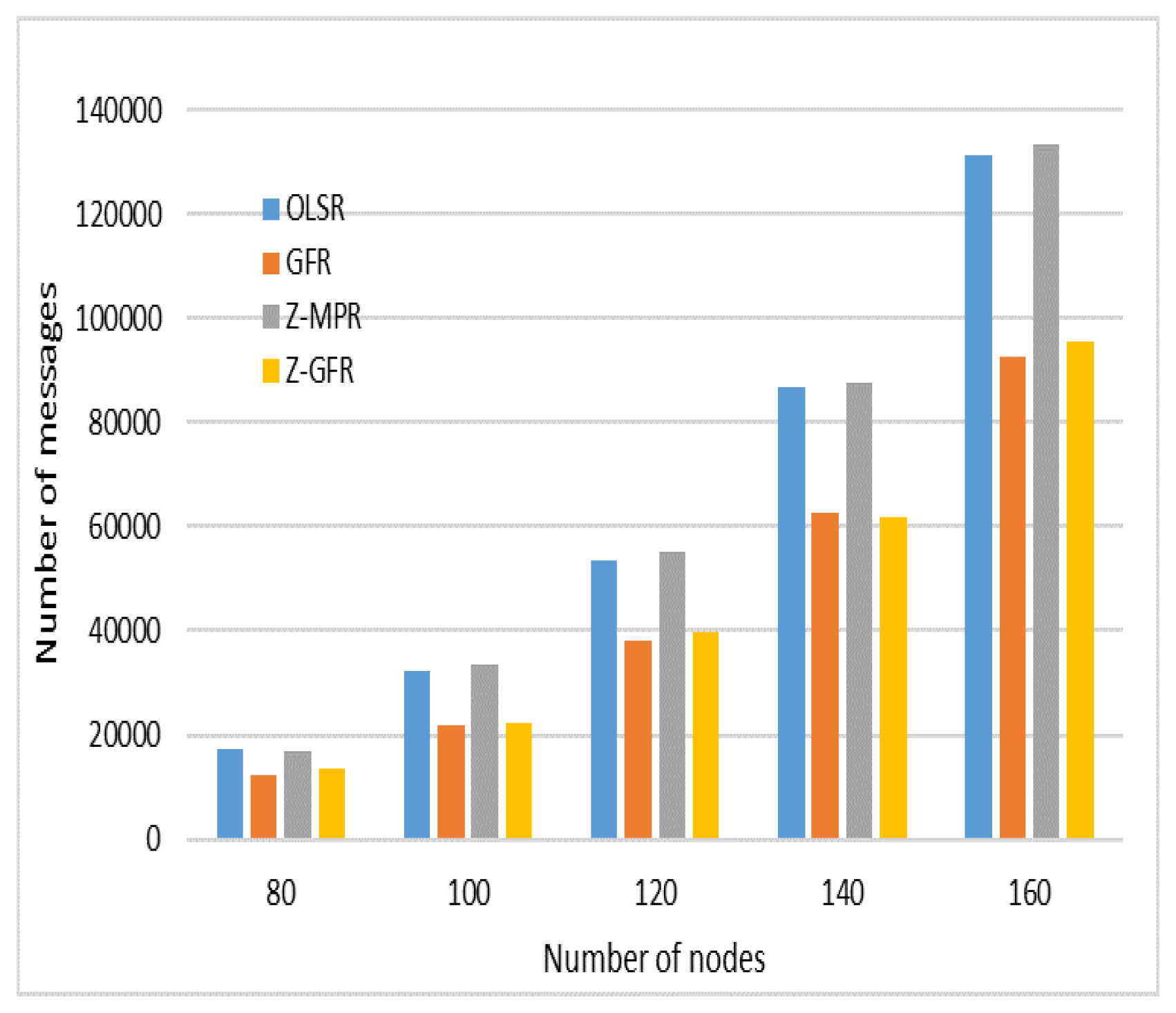
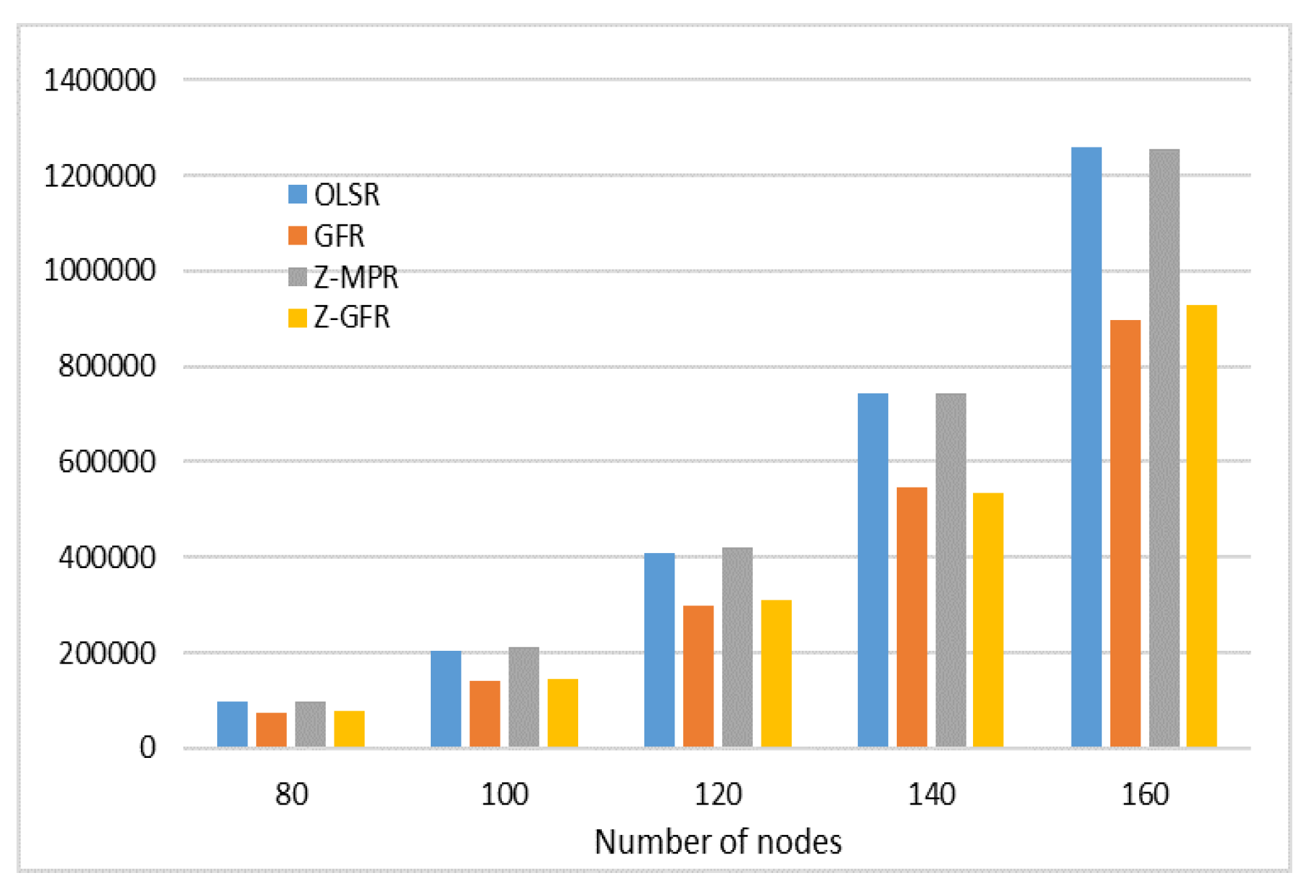
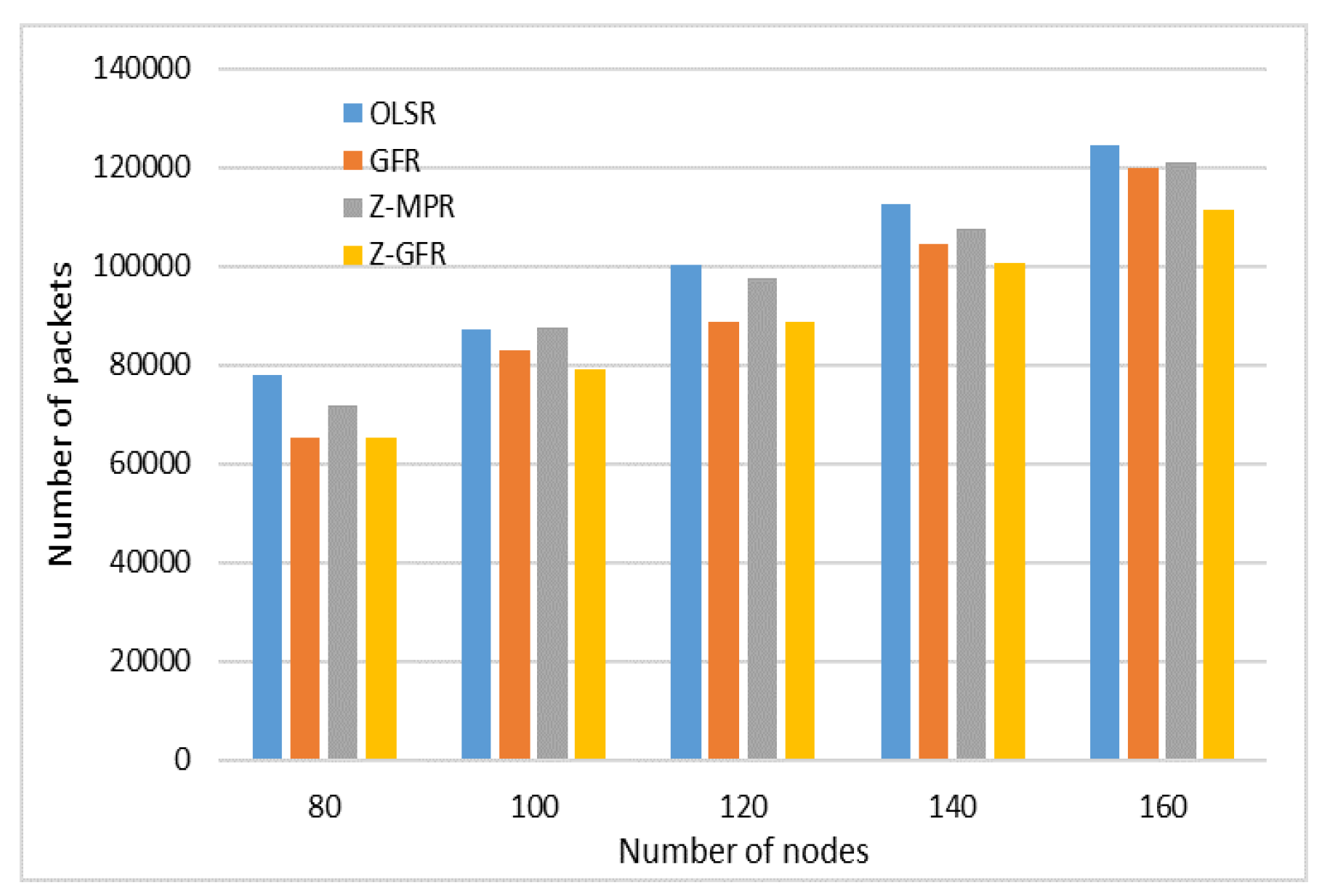
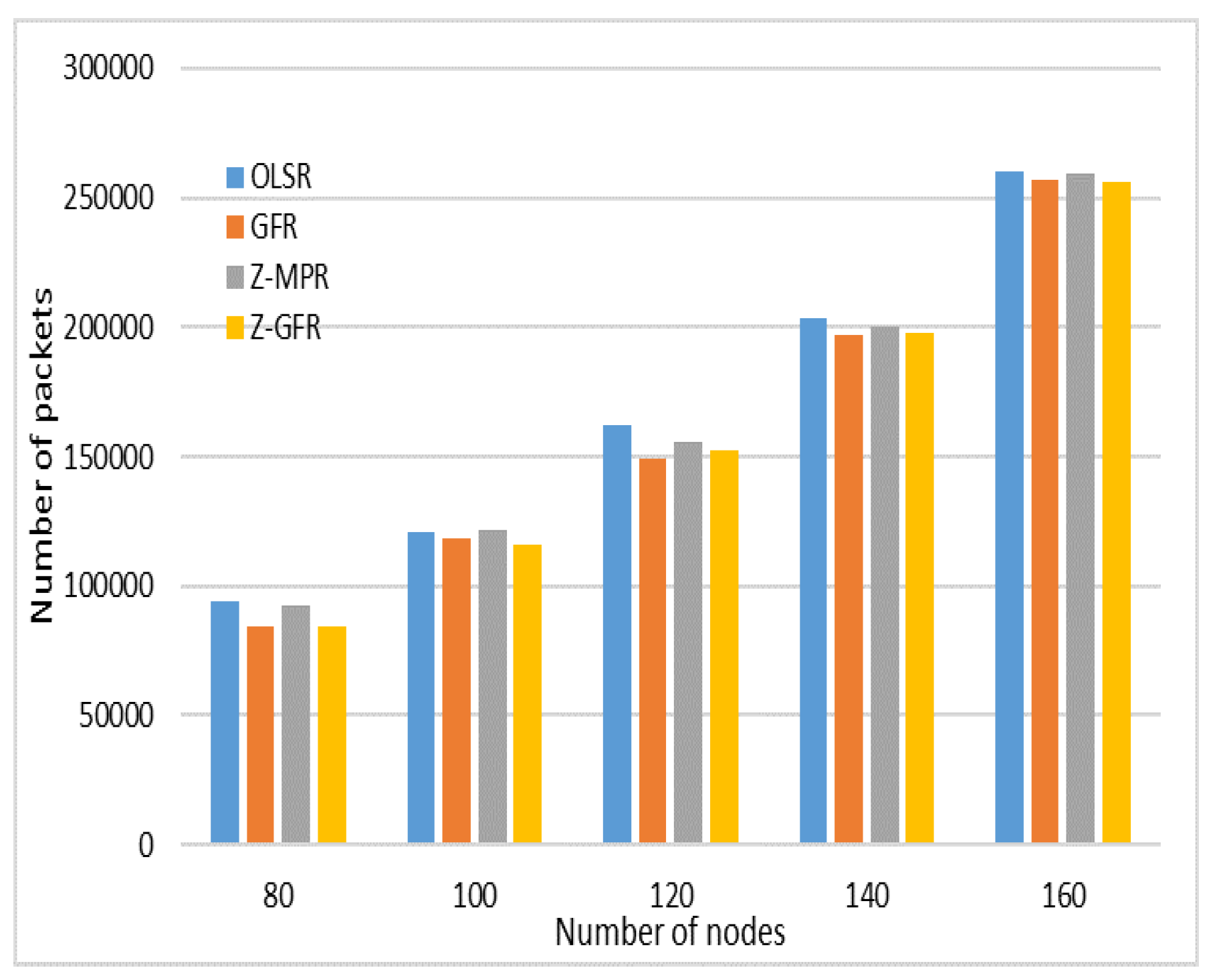
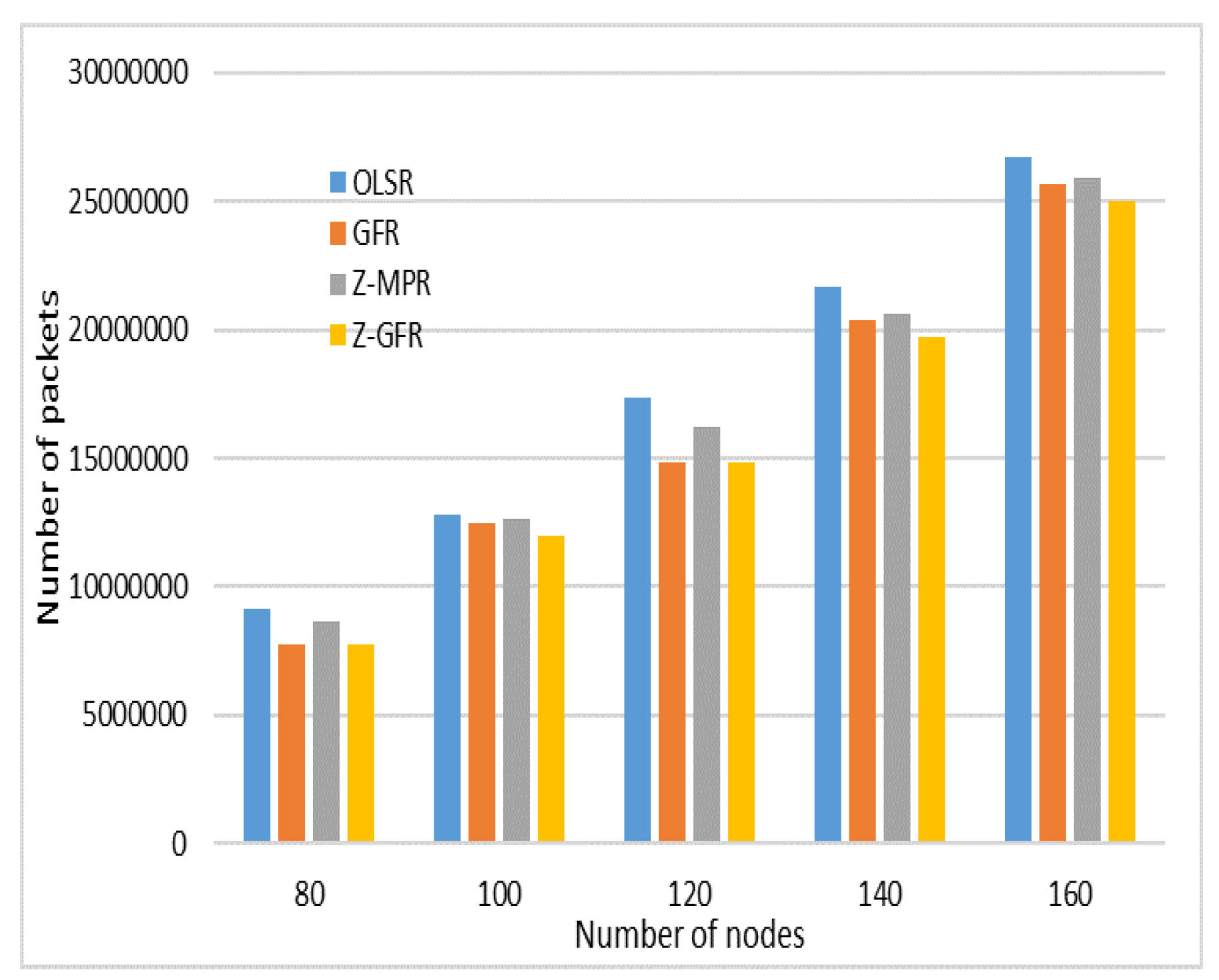
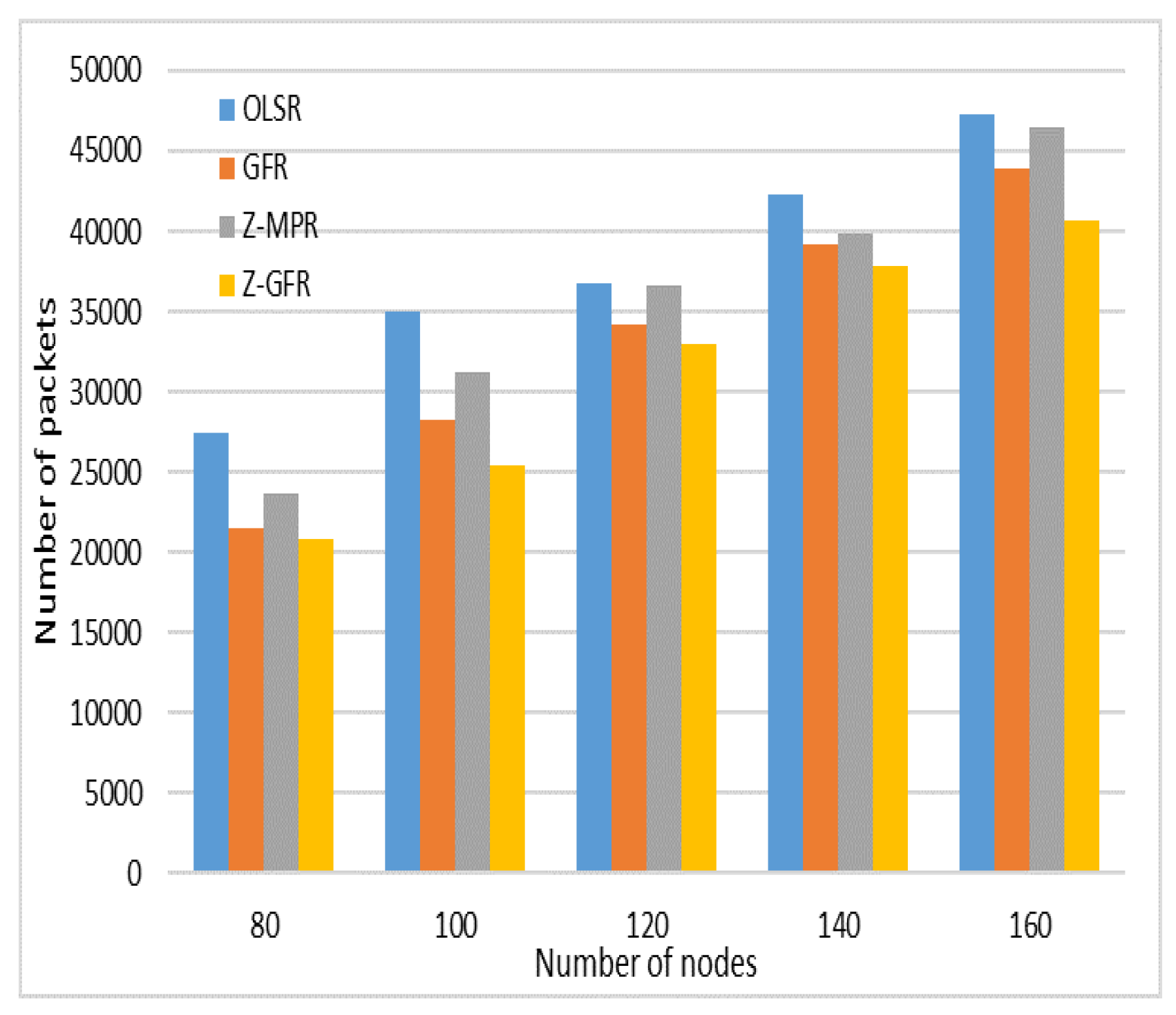
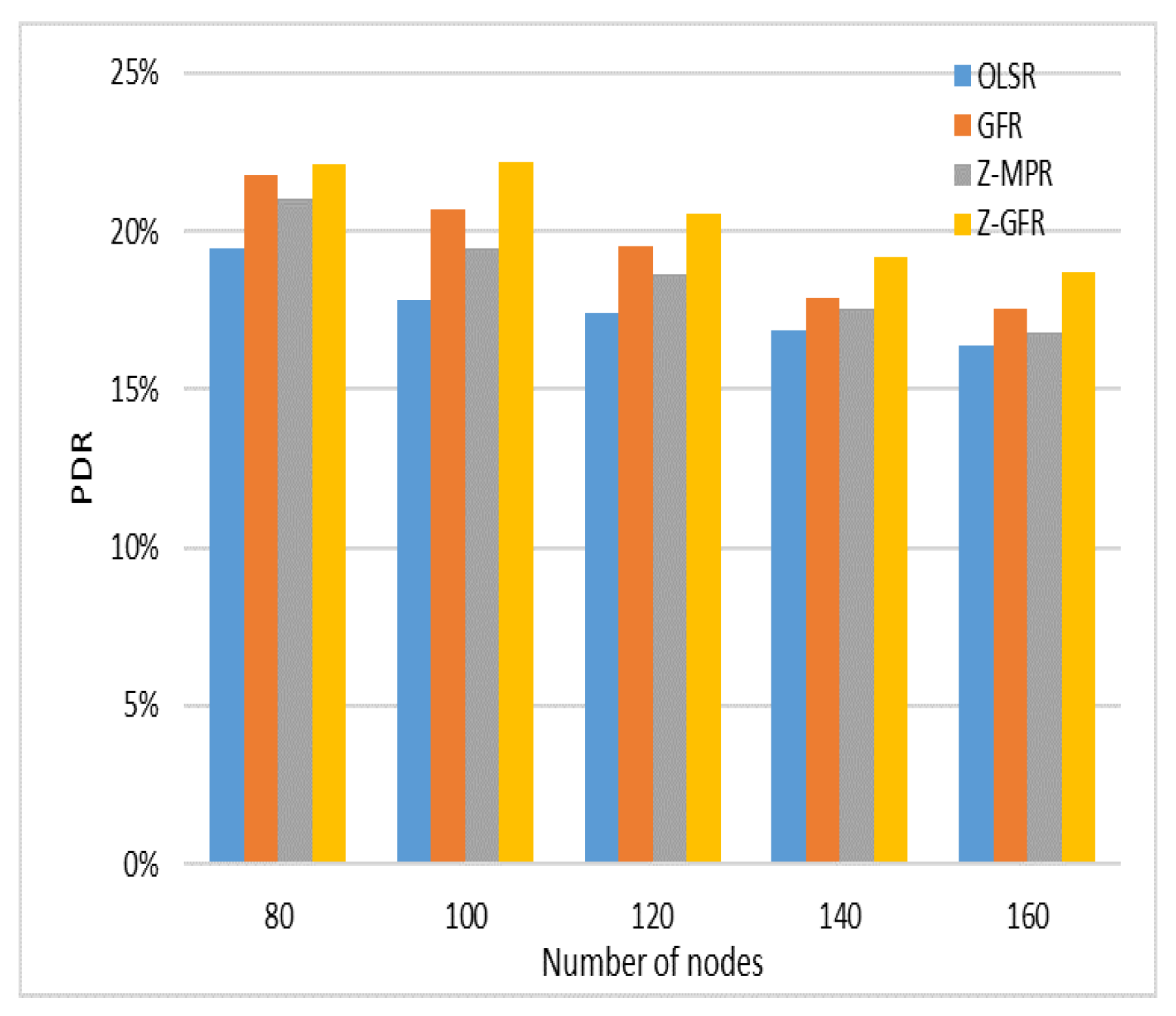
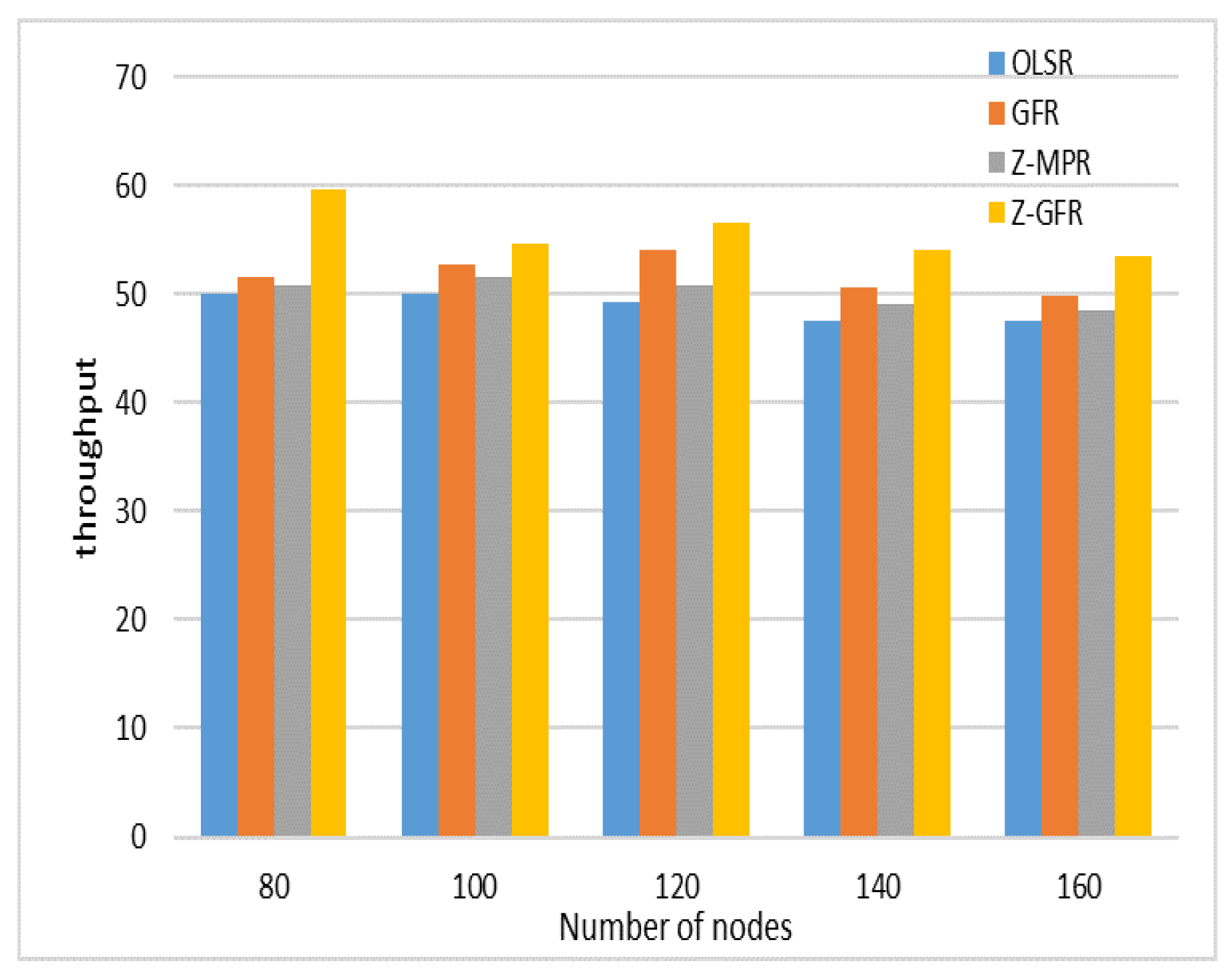
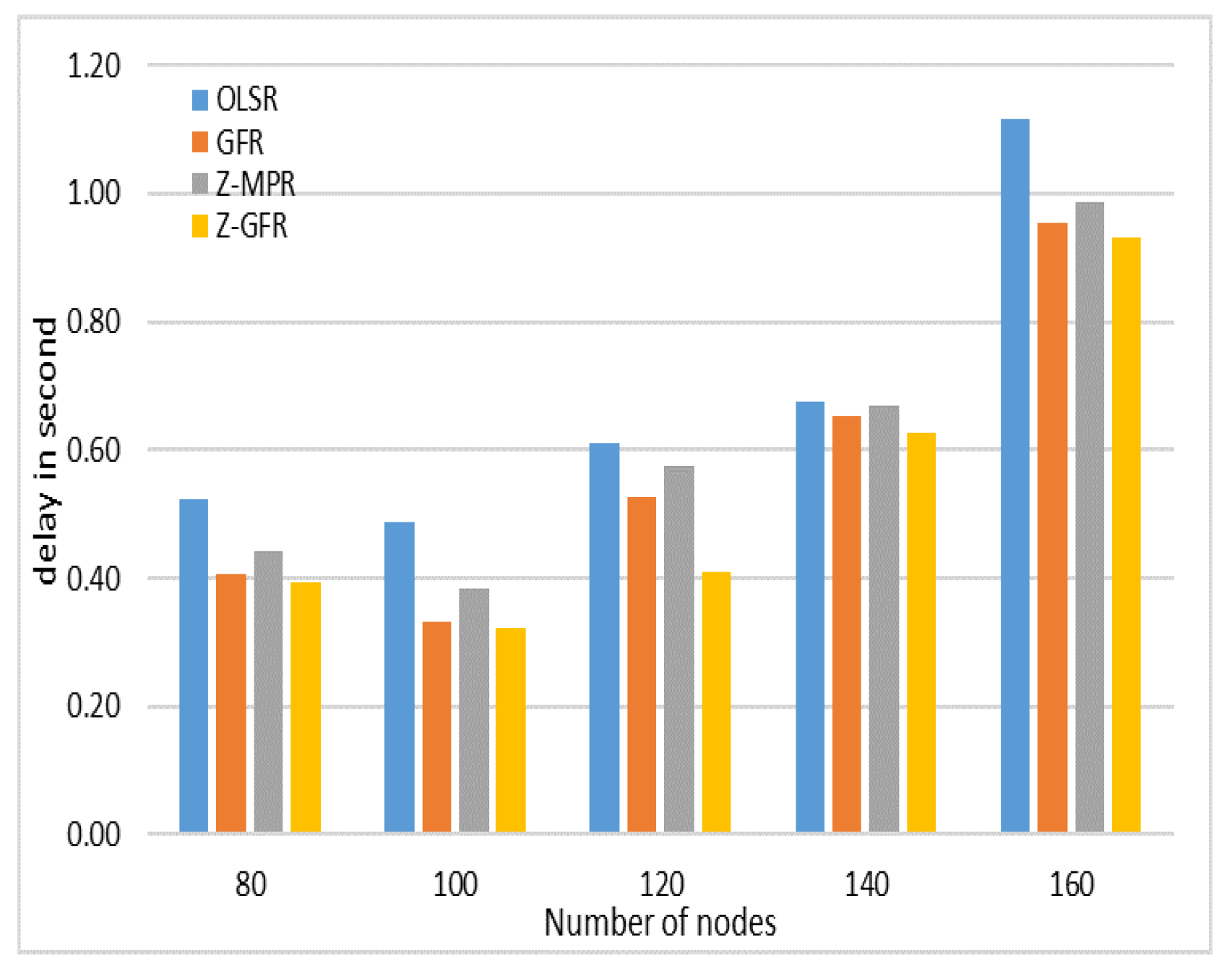
| Simulation Environment | Parameters |
|---|---|
| Area size | 1000 m × 1000 m |
| Number of nodes | 80, 100, 120, 140, 160 |
| Radio range | R = 100 m |
| Modulation | 802.11b peer to peer mode |
| DataMode | DsssRate1Mbps |
| ControlMode | DsssRate1Mbps |
| Mobility model | Random Mobility |
| Simulation time | 100 s |
© 2019 by the authors. Licensee MDPI, Basel, Switzerland. This article is an open access article distributed under the terms and conditions of the Creative Commons Attribution (CC BY) license (http://creativecommons.org/licenses/by/4.0/).
Share and Cite
Souidi, M.; Habbani, A.; Berradi, H. Hybrid Zoning Algorithm to Optimize Overhead in Smart Mobile Communication. J. Sens. Actuator Netw. 2019, 8, 53. https://doi.org/10.3390/jsan8040053
Souidi M, Habbani A, Berradi H. Hybrid Zoning Algorithm to Optimize Overhead in Smart Mobile Communication. Journal of Sensor and Actuator Networks. 2019; 8(4):53. https://doi.org/10.3390/jsan8040053
Chicago/Turabian StyleSouidi, Mohammed, Ahmed Habbani, and Halim Berradi. 2019. "Hybrid Zoning Algorithm to Optimize Overhead in Smart Mobile Communication" Journal of Sensor and Actuator Networks 8, no. 4: 53. https://doi.org/10.3390/jsan8040053
APA StyleSouidi, M., Habbani, A., & Berradi, H. (2019). Hybrid Zoning Algorithm to Optimize Overhead in Smart Mobile Communication. Journal of Sensor and Actuator Networks, 8(4), 53. https://doi.org/10.3390/jsan8040053





